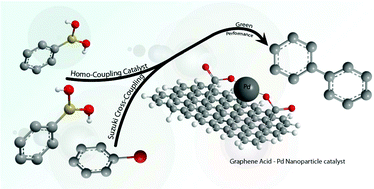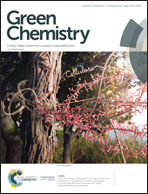Palladium nanoparticles supported on graphene acid: a stable and eco-friendly bifunctional C–C homo- and cross-coupling catalyst†
Abstract
A mild impregnation of graphene acid (GA) with Pd(OAc)2 yields Pd nanoparticles with a size that can be easily controlled by the amount of the Pd precursor, and with a sharp and tunable size distribution ranging from 1 nm up to 9 nm. The spectroscopic and microscopic characterization of the GA–Pd composites reveals a strong interaction between the metal and the carboxyl groups of the GA support, and suggests a nanoparticle growth mechanism entailing counterion metathesis followed by a GA promoted reduction. The GA–Pd nanohybrids are highly active catalysts in the Suzuki–Miyaura cross coupling reaction under environmentally-friendly conditions. TOF values exceeding 30 000 h−1, high selectivity toward the coupling product and versatility for a large variety of substrates are reported. Given the large amount of carboxyl groups, the catalysts are exceptionally stable, and no appreciable metal leaching is observed during the reaction. Notably, at variance with conventional carbon and graphene supports, the GA supported Pd nanoparticles show a bifunctional activity and can yield biphenyl adducts upon oxidative homocoupling of arylboronic acids.



 Please wait while we load your content...
Please wait while we load your content...